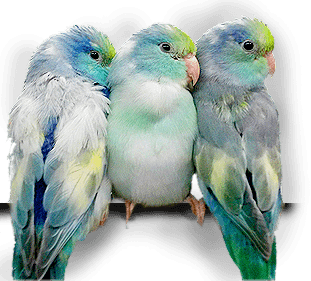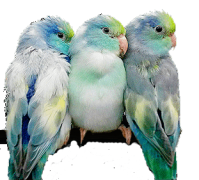Nutrition
Your pet bird’s diet is critical to its overall care. Adequate feeding plans may be developed from a wide variety of commonly available foods, or you may offer any one of the several formulated diets that are especially designed for certain species of birds by commercial companies. Dietary needs vary somewhat with the species. Ask you veterinarian for feeding recommendations.
The bird should be on the best possible diet of all of the time not just during the normal breeding season or when the bird is moulting. The bird may need more food during certain times such as breeding or moulting. The bird should never be on a diet that “needs improving”.
Environment
Temperature: A healthy bird can tolerate temperatures that are comfortable to its human companion. Sudden changes in temperature may be a potential threat to a sick bird.
Humidity: Pet birds can adapt to a wide range of humidity levels as most birds are native to subtropical climates but they may benefit from an occasional increased humidity in the home. (ex. In the bathroom while the shower is running or frequent misting of the feathers with water).
Light and Fresh Air: Opportunities for supervised access to fresh air and direct sunlight (not filtered through glass or plastic) appear to be beneficial as long as shade is available.
Housing
The largest cage that can be accommodated in the home is recommended for birds that are confined most of the time. The cage must be strong enough to resist bending or dismantling by the bird, made of non-toxic materials, and designed for the safety and ease of cleaning. In most cases, the cage would need to be wider than it is tall this allows for stretched wings; however ample height should be provided for long tailed birds.
Perches: Natural wood branches, appropriately sized, and free from pesticides and non-toxic trees such as hardwoods (ex. Northern hardwoods, Citrus, Eucalyptus, and Australian pine) are clean, easily replaceable and inexpensive. Some well placed perches may be adequate for agile climbers because they tend to prefer the highest perch if multiple perches are provided. More perches can be placed in larger cages as long as they do not overcrowd the cage. Perches should be placed to prevent droppings from contaminating the water and food receptacles and prevent the bird’s tail from coming into contact with the food and water receptacles or the floor of the cage where feces is present.
Food and Water Bowls: The use of wide food bowls or deep cups will depend on the type of bird. Healthy birds with normal ambulatory skills can easily approach food and water bowls; therefore, it is not necessary to place them directly beside the perch. Birds often overeat or chew on food dishes out of boredom. Placing the food at the opposite end of the cage from the water will ensure that the birds gets some exercise between eating and drinking. Two sets of dishes are recommended so one set can be cleaned while the other is being used.
Hygiene: A daily cleaning of the cage floor and bowls helps to prevent problems with food spoilage and permits the caretaker or owner to inspect the cage floor. Blood on the floor or unusual condition of dropping (feces and urates) can alert the owner or caretaker to signs of potential illness. It is important to thoroughly clean the cage each week.
Cage Liners and Substrates: The appearance and number of droppings can be better monitored if newspapers, paper towels, or other plain cage liner paper is used as a substrate rather than wood chips, corn cob bedding, kitty litter or sand. Birds should not be allowed direct contact with the substrate as it tends to grow bacteria and fungus.
Security: Many birds benefit from the availability of a retreat (ex. Paper bag, towel or nest box) inside the cage for a sense of privacy.
Activity
Most pet birds are intelligent, active animals whose psychological needs must be identified and addressed. Place the cage near family activity in the home. For some species, opportunities for exercise may include supervised freedom from the cage so the bird can fly in the home. If the bird is permitted to fly, be aware of ceiling fans, large windows, hot pans on the stove, and open doors as these can pose potential threats of injury to your bird.
Toys: Toys are useful as mental diversions and tend to encourage physical exercise and beak wear; however, they must be selected with the safety of the bird in mind. “Chewable” items include branches, pinecones, rawhide toys, and soft white pine. Many enhancements to the cage and home can occupy the bird’s attention. Some birds like to tear paper and enjoy the cardboard from a toilet paper roll, paper towel roll; others may like a piece of corn cob or pomegranate. You can also place a roll of adding machine paper on a dowel, for the bird to unravel and chew. This proves to be good “occupational therapy”.
Minimal care is required for the healthy well-fed pet bird. Confined, indoor pet birds that an all seed diet usually require more care for the beaks, nails, feet and feathers.
As a new feather develops, the bird may pick at the pin feather to remove the cover and open the feather. This should not be interpreted as “feather picking” or reaction to the presence of mites. Pure water is the most appropriate feather spray.
Keep feathers free of oily substances. Soiled feathers may be gently cleaned with a mild detergent solution (ex. Dawn liquid, baby shampoo) and followed by a thorough rinsing and drying.
A wing clip may prevent escape or injury, and may be desired for taming and training. Your veterinarian can advise you about wing clipping.
Opinions differ as whether or not leg bands need to be removed. If a closed band is left on the leg for identification purposes check under the band occasionally for signs of dirt accumulation, swelling, or constriction of the leg.
Most birds enjoy daily bathing. Some will bathe in a dish or bowl while others prefer a large handful of wet lettuce leaves or a gentle misting with a water bottle. If the bird resists any form of bathing, a daily misting with clean water will encourage it to groom itself and will keep the bird clean. Do Not add anything to the bath water.
An annual visit to your veterinarian for a routine health examination is advised for early detection of potential problems and diseases.


